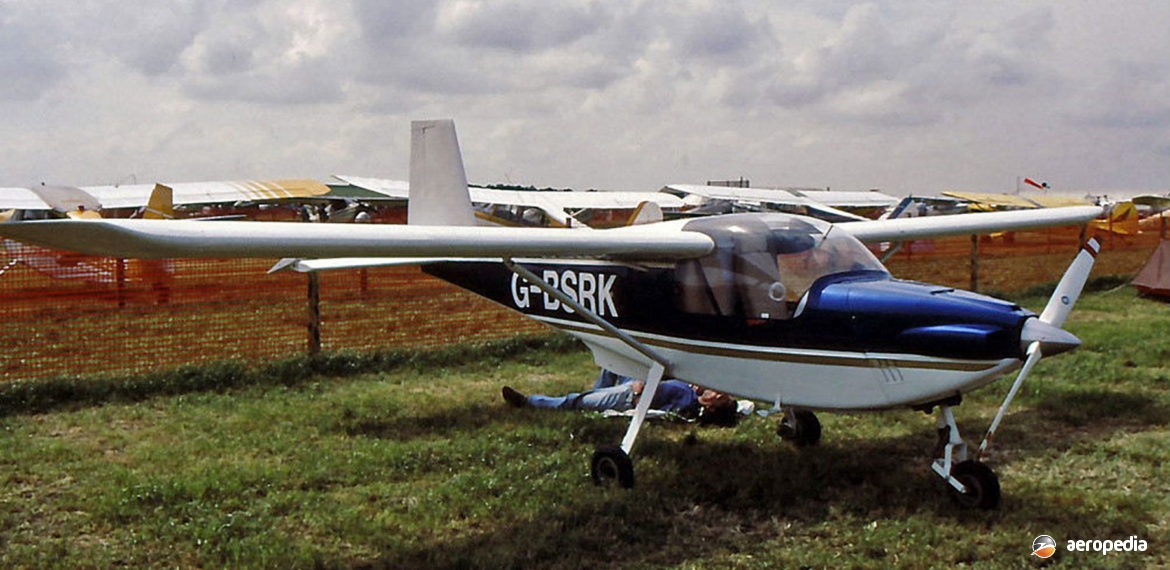Photograph:
ARV Super 2 G-BSRK (ex- ZK-FSQ) in the United Kingdom in 1991 (Derek Heley – Air Britain)
Country of origin:
United Kingdom
Description:
Two-seat light touring and training monoplane
Power Plant:
One 57 kw (77 hp) Hewland Ae-75 three-cylinder, two-stroke, in-line liquid-cooled engine
Specifications:
- Wingspan: 8.96 m (28 ft 6 in)
- Length: 5.09 m (16 ft 8½ in)
- Height: 2.31 m (7 ft 7 in)
- Wing area: 8.59 m² (92.5 sq ft)
- Max speed at 1,066 m (3,500 ft): 177 km/h (110 mph)
- Economical cruising speed at 1,066 m (3,500 ft): 153 km/h (95 mph)
- Max rate of climb at sea level: 244 m/min (800 ft/min)
- Stalling speed flaps up: 95 km/h (59 mph)
- Stalling speed flaps down: 83 km/h (52 mph)
- Range with max fuel: 685 km (426 miles)
- Empty weight: 288 kg (635 lb)
- Loaded weight: 499 kg (1,100 lb)
History:
The ARV Super 2 was a new design using state of the art technology to produce a light, cheap, economical training aircraft to meet the requirements of aero clubs, and was expected to compete on the world’s markets with the French designed Robin ATL. The prototype (G-OARV) was flown for the first time on 11 March 1985, and was followed by a second prototype on 12 November 1985 at Sandown on the Isle of Wight, a third following early in 1986.
The type was to be sold as a complete aircraft or in kit form, the latter being 65% complete. It was conventional in appearance but used state of the art technology to meet its design parameters. Construction was of super-plastically formed aluminium alloy pressings which made possible double curvatures for improved styling. The engine was a unit designed for light aircraft use by Hewland Engineering, manufacturers of engines and gearboxes for racing cars for many years. The wings were removable to facilitate transport by road.
The Norton, Hewland or Mid-West engine, as it became known, was a liquid-cooled single rotor Wankel engine with dual ignition for light aircraft produced by Mid-West Engines Ltd at Staverton Airport, Gloucestershire, UK. It was produced in a number of models, but the basic units for light aircraft were the AE-50R single-rotor of 294 cc which provided 41 kw (55 hp) at 7,750 rpm; and the AE-75R, also a single-rotor unit of 404 cc which produced 56 kw (76 hp) at 7,000 rpm.
Shortly after entering production a series of forced landings of the type caused by gearbox failures attributed to propeller vibration resulted in the UK Civil Aviation Authority grounding the type. These problems were quickly rectified but publicity about the problems with the aircraft led to a loss of market and cancelling of orders. The manufacturer ARV Ltd went into administration.
Rights to the design were later obtained by Island Aircraft and consideration was given to producing the aircraft on the Isle of Wight but soon a production line was established with Aviation Scotland Ltd (ASL). This was not completely successful and a joint venture was established with Uddeholm Tooling in Sweden in 1993. Kits produced in Scotland, which were known as the Optus, were to be assembled in Sweden.
Upgrades to the design included the installation of the more reliable Rotax 912 engine, and when sold in kit form it was to be known as the Highlander. However, there were more problems for the design. The Swedish assembler became ASL Hagford Aero but in 1995 this company closed its doors. By this time the aircraft had become known as the Opus 280.
In later times production recommenced, this time in Pris, Ohio in the USA with Skycraft International. As the Hewland engine was not particularly successful, other engines were fitted to Super 2s built as kits, and these have included the 60 kw (80 hp) Rotax 912, 75 kw (100 hp) Rotax 912S, 86 kw (115 hp) Rotax 914, and MWE rotary, which was fuel-injected and electronically managed.
It seems about 40 examples of the Super 2 were built, 35 on the Isle of Wight, three in Sweden from components on hand, one in Canada and one kit in the USA by Highlander Aircraft. Most survivors have been re-engined with Rotax or Jabiru engines.
Two examples were imported to New Zealand by Alternate Aviation of Auckland, these being serial numbers 07 and 014. One became ZK-FSQ (c/n 07) and was put through a flight test programme in 1990. However, due to problems with the engine, both aircraft were returned to the United Kingdom in the 1990s, ZK-FSQ becoming G-BSRQ. The aircraft was badly damaged in 1995 in the United Kingdom when the engine failed and it made a forced landing. The fate of the second ircraft ils not known.

